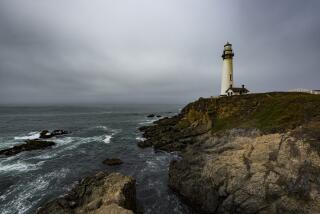Northern Extremes
DAWSON, Canada — Anne Saunders has lived here for 15 years. She likes the town, but that’s not what keeps her tethered.
“Much as I love Dawson,” she said, “the Dempster is why I live here.”
Reaching north for 457 miles, the Dempster Highway runs from Dawson in the Yukon to Inuvik in the Northwest Territories, two degrees north of the Arctic Circle. Sitting atop the permafrost and weathering temperatures that can vary as much as 142 degrees, the Dempster is entirely gravel, 20 feet thick in places.
Mile Post 0 of the Dempster stands just outside this colorful turn-of-the-century Gold Rush town in the middle of the Yukon. Century-old wood buildings here sit askew, and miners still pawn their pokes of dust at the General Store on Front Street for a season’s worth of grub.
In the summer Dawson welcomes thousands of visitors who come here to stroll, shop for antiques, explore historic mines and old log cabins, and catch the Gaslight Follies at the Palace Grand Theatre.
The Dempster, by contrast, is legendary for the isolated landscape it traverses and the flora and fauna it showcases along the way. Saunders, whose hobby is photographing wildflowers, drove the Dempster 25 times last summer, she told me.
For most of its length, the land the Dempster crosses bears no sign of human passage or presence: no side roads, no houses, no telephone or power poles, no scars upon the land. There is but a single hotel/service station complex midway. On the road, travelers routinely spot grizzlies, black bears, moose, caribou, Dall sheep and many species of birds.
Having heard glowing accounts of Dawson and the Dempster, I decided to see for myself and timed my drive to be in Inuvik on the summer solstice, the first day of summer when the sun won’t set again for nearly two months.
I flew to Whitehorse, the Yukon’s capital, and rented an SUV at the airport, then headed north for 330 miles on the quiet Klondike Highway to Dawson. As I drove, the trees got smaller, and the sky got bigger. By the time I reached Dawson, I was beginning to understand why it’s said that the Yukon is the place Alaskans go to get away from it all. The entire territory--at 205,345 square miles, about the size of California and Tennessee combined--has just 31,000 people, and I had left 23,000 of those behind in Whitehorse.
Dawson, with 1,800 people, is the Yukon’s second-largest community and sits at the juncture of the Klondike and Yukon rivers. In August 1896, Skookum Jim and some mining buddies found gold just outside Dawson at Bonanza Creek, kicking off the Klondike Stampede. Dawson shot up overnight, adding boardwalks, barrooms, bordellos and boardinghouses. It’s a fun town to visit, and like many Dempster drivers, I tarried for a couple of days before setting out and felt transported to another era.
And then it was time to go.
Before the Dempster, the only way into Canada’s Western Arctic was by bush plane or dog sled. The Dempster Highway project was begun in 1958, following a route laid out by native trapper Joe Henry, who lived in Dawson. In 1964 the entirely gravel highway (asphalt cannot be used because of the shifting permafrost) had reached only to the 120-mile mark at Chapman Lake. It wasn’t until 1979 that the Dempster was officially completed all the way to Inuvik.
It was 80 degrees at the service station in Dawson when I topped the tank. The next gas station was not for about 250 miles. Soon after I entered the Dempster the scenery changed dramatically.
Rounded hills turned into jagged peaks with snow highlighting the crannies. The landscape was carpeted with dwarf birch, stunted spruce and Arctic willows that in southern climes would be thick forest.
Although only about 60 miles from Dawson, I stopped the first night at the Tombstone Park Campground alongside the North Fork of the Yukon. The Tombstone region has the most easily accessible hiking of any place along the Dempster. The park warden here in the summer leads evening interpretive hikes into the surrounding hills.
I joined half a dozen fellow campers on a scenic traipse over springy moss and crispy lichens. The view was spectacular, and the air deliciously fresh.
Back at camp, I sat near the tent by the river reading a book of poetry by Robert Service. The so-called “Canadian Kipling” lived in the Yukon for eight years and wrote his most famous works in a little log cabin in Dawson. Though I read well into the night, there was no need for a flashlight. At midnight, the sky was blue, and white clouds cast shadows.
Weather can change rapidly here. By 6 a.m., rain clouds had blown in, and by midmorning it was chilly and much darker than the previous night’s “dusk.” At Mile 64, just beyond the aptly named Two Moose Lake, I saw my first Alaska Yukon (or Tundra) moose, the largest in North America. The big bull, about 7 feet at the shoulder, was standing in the middle of the road. I never realized how big they really are. As I fumbled for my camera, he loped out of sight.
The Dempster weaves in and out of the tree line, and the tundra begins where the trees end. “Have you walked on the tundra?” reads an interpretive placard on the roadside. “Try it. It’s not as easy at looks!” I stopped near one of a thousand nameless thaw lakes and got out.
Walking on the spongy sedges, mosses and lichens of the tundra was slow but not difficult. Where the tundra turned into muskeg, however, as it did along the shoreline and in the low-lying areas, difficult became impossible. Each footstep sank deep into the boggy vegetation, and cold water seeped over the tops of my hiking boots and soaked my socks. I understood then why people here wait for freeze-up before trying any cross-country travel.
As I slogged through the muskeg, the Arctic terns attacked. They divebombed me, zooming down with their feet outstretched and squawking fiercely. The Dempster is a birder’s paradise, and I had blundered onto a nesting ground. These guys have a long annual migration--24,000 miles from here in the Arctic down to the Antarctic and back again.
The temperature continued to drop rapidly, and by the time I reached Eagle Plains Hotel at Mile 229, just 22 miles south of the Arctic Circle, snow was blowing across the road. The pass ahead had been closed, and a gate with red flashing lights blocked the roadway. No one would be driving any farther today.
Rooms at the hotel, the only one along the entire Dempster, were snug and warm if nondescript. The constant sunshine soon melted the freak late snow, and by noon the next day, the roadway had already dried.
The Dempster crosses the Arctic Circle at a scenic overlook amid the Richardson Mountains (Mile 252). An interpretive display there claims that the Arctic gets as much solar energy in one 24-hour period in the summer as the equator gets in a similar period. No wonder summer growth is so rapid.
Blue lupines, fireweed, foxtails, wild roses and even sunflowers colored the roadside.
About 60 miles after crossing the circle, the Dempster leaves the Yukon and enters the Northwest Territories. On the NWT side are two river crossings, at the Peel and the Mackenzie. Both have free ferries. I slipped onto both behind only two other vehicles.
Inuvik is less than two hours’ drive beyond the Mackenzie ferry. A no-nonsense far-north working town, Inuvik is the life support for the entire Western Arctic with airport, banks, hotels, mechanics and more. I checked into a small cabin at the Arctic Chalet, chowed down on a flavorful but coarse-textured musk ox burger at To Go’s for lunch and visited the new community greenhouse, curious to see an Arctic garden.
No one was there when I arrived, but soon Anne Dahlseide, one of the gardeners, dropped by and showed me around. There were 70 thriving raised beds (everything is raised here--above the permafrost) each lovingly tended by a different gardener. “It’s only our third year, and already we have a waiting list of 37,” she said. “We’re still experimenting. We really don’t know what seeds will grow up here, but we do grow good zucchinis.”
From late fall to late spring, the frozen Mackenzie River becomes an ice road that continues the Dempster route on to Tuktoyuktuk on the Arctic shore, about 80 miles north of Inuvik. In summer, however, you must fly to Tuk. Cultural excursions are offered by an Inuvik tour company that include the round-trip flight. They fill rapidly because many people who drive the Dempster want to go all the way and see the Arctic Ocean. I booked a full day cultural tour that included a traditional meal in a resident’s house.
The plane departed at 9:30 a.m. for the scenic 40-minute flight along the edge of the immense Mackenzie River Delta. We soon left behind the last traces of the boreal forest. In its place spread blue lakes with patches of bright white ice and green-brown tundra puckered like alligator skin. Ninety percent of Tuk’s population of about 1,000 is Inuvialuit (meaning “original people”) of the Western Arctic, formerly known to outsiders as Eskimos.
After a tour of the town and the beach, where all but one of the tourists bowed to tradition and dipped their feet in the Arctic Ocean (I don’t like cold water), we went to the home of James and Maureen Pokiak. Like most Inuvialuits in Tuk, they hunt, trap, fish and whale for their yearly food supply.
Maureen laid out a traditional Inuvialuit lunch: caribou soup, bannock, dry fish, smoked beluga whale meat, whale oil and boiled maktaaq, or muktuk, the narrow layer of blubber between the whale skin and the fat. “I boil it about an hour in the smokehouse,” she said. It tastes something like tofu boiled in rank fish sauce with a touch of bacon drippings.
To the Inuvialuits, muktuk (boiled or raw) is the most coveted of all delicacies. Many dip it in whale oil, which is used here much like some people use butter or mayonnaise. A small tub of strong-smelling whale oil sat in the middle of the table.
Although whalers used it for lantern oil, they never ate it, and they often suffered from scurvy, a nutritional disease caused by lack of vitamin C.
The Inuvialuits knew nothing about the disease, even though their diet was almost completely without vitamin-rich vegetables. Whale oil is a good source of vitamin C.
Back in Inuvik, the Mackenzie Delta Drum Dancers put on a great show with traditional Inuvialuit dances and music at Jim Koe Park. This dance was a celebration of the summer solstice (although dances go on all summer). Today was officially summer, and the sun wouldn’t set again in this part of the Arctic for 59 days.
At 1 a.m. I woke with sunlight streaming in my eyes. I looked out and saw the full moon beckoning in the south. It was too much.
When would I get another chance to drive across the tundra under the midnight sun?
I grabbed my gear, slipped on a pair of sunglasses, and headed south for Dawson.
Carl Duncan is a freelance writer living on Salt Spring Island, Canada.
More to Read
Sign up for The Wild
We’ll help you find the best places to hike, bike and run, as well as the perfect silent spots for meditation and yoga.
You may occasionally receive promotional content from the Los Angeles Times.






